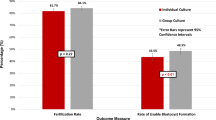Abstract
Purpose: The aim of this study was to examine the influence of endometrial cells on the fertilization rate and early embryonic morphology following routine in vitro fertilization (IVF). Cryopreservation with subsequent thawing allowed the use of autologous somatic cells, thus minimizing the risk of transmission of infective agents. Interpatient variability was eliminated by randomizing oocytes from each cycle into the control or coculture group.
Results: Two hundred ninety-four oocytes from 24 IVF cycles (21 patients) were included in the study (145 coculture and 149 control). The normal fertilization rate of control oocytes (56.4%) was not significantly different from that of oocytes cocultured with endometrial cells (61.4%). The mean number of blastomeres in cocultured embryos (3.65) was not significantly different from the number in control embryos (3.46) 2 days after insemination, but the proportion of embryos with minimal or no fragmentation was significantly higher in the coculture group [34/84 (40.5%) vs.17/80 (21.3%);P<0.01].
Conclusions: The inclusion of cryopreserved autologous endometrial cells in routine clinical IVF procedures does not influence fertilization or the early cleavage rate but may reduce the extent of embryo fragmentation during the early cleavage divisions.
Similar content being viewed by others
References
Ghosh D, Sengupta J, Edgar DH, de Ziegler D: Debate: Endometrial receptivity for implantation. Hum Reprod 1995;10:1–7
Cohen J, Elsner C, Kort H, Malter H, Massey J, Mayer MP, Wiemer K: Impairment of the hatching process following IVF in the human and improvement of implantation by assisting hatching using micromanipulation. Hum Reprod 1990;5:7–13
Bongso A, Fong C-Y, Ng S-C, Ratnam S: The search for improved in-vitro systems should not be ignored: Embryo coculture may be one of them. Hum Reprod 1993;8:1155–1160
Wiemer KE, Cohen J, Wiker SR, Malter HE, Wright G, Godke RA: Coculture of human zygotes on fetal bovine uterine fibroblasts: Embryonic morphology and implantation. Fertil Steril 1989;52:503–508
Menezo YJR, Guerin J-F, Czyba J-C: Improvement of human early embryo development in vitro by coculture on monolayers of Vero cells. Biol Reprod 1990;42:301–306
Bongso A, Ng S-C, Fong C-Y, Anandakumar C, Marshall B, Edirisinghe R, Ratnam S: Improved pregnancy rate after transfer of embryos grown in human fallopian tubal cell coculture. Fertil Steril 1992;58:569–574
Quinn P: Use of coculture with cumulus cells in insemination medium in human in vitro fertilisation (IVF). J Assist Reprod Genet 1994;11:270–277
Mansour RT, Aboulghar MA, Serour GI, Abbass AM: Coculture of human pronucleate oocytes with their cumulus cells. Hum Reprod 1994;9:1727–1729
Freeman MR, Whitworth CM, Hill GA: Granulosa cell coculture enhances human embryo development and pregnancy rate following in-vitro fertilisation. Hum Reprod 1995;10:408–414
Jayot S, Parneix I, Verdaguer S, Discamps G, Audebert A, Emperaire J-C: Coculture of embryos on homologous endometrial cells in patients with repeated failures of implantation. Fertil Steril 1995;63:109–114
Gook DA, Osborn SM, Bourne H, Johnston WIH: Fertilisation of human oocytes following cryopreservation; Normal karyotype and absence of stray chromosomes. Hum Reprod 1994;9:684–691
Rosenboom TJ, Vermeiden JPW: Evaluation of embryo scoring systems and their value in predicting in vitro fertilisation outcome. Assist Reprod Rev 1995;5:53–59
Bongso A, Ng S-C, Fong C-Y, Ratnam S: Improved fertilisation rates of human oocytes in coculture. J Vitro Fert Embryo Transfer 1991;8:216–221
Plachot M, Mandelbaum J, Junka AM, Antoine JM, Salat-Baroux J, Cohen J: Co-culture with granulosa cells does not increase the fertilisation rate in couples with previous fertilisation failures. Hum Reprod 1993;8:1455–1458
Author information
Authors and Affiliations
Rights and permissions
About this article
Cite this article
Nieto, F.S., Watkins, W.B., Lopata, A. et al. The effects of coculture with autologous cryopreserved endometrial cells on human in vitro fertilization and early embryo morphology: A randomized study. J Assist Reprod Genet 13, 386–389 (1996). https://doi.org/10.1007/BF02066169
Received:
Accepted:
Issue Date:
DOI: https://doi.org/10.1007/BF02066169



